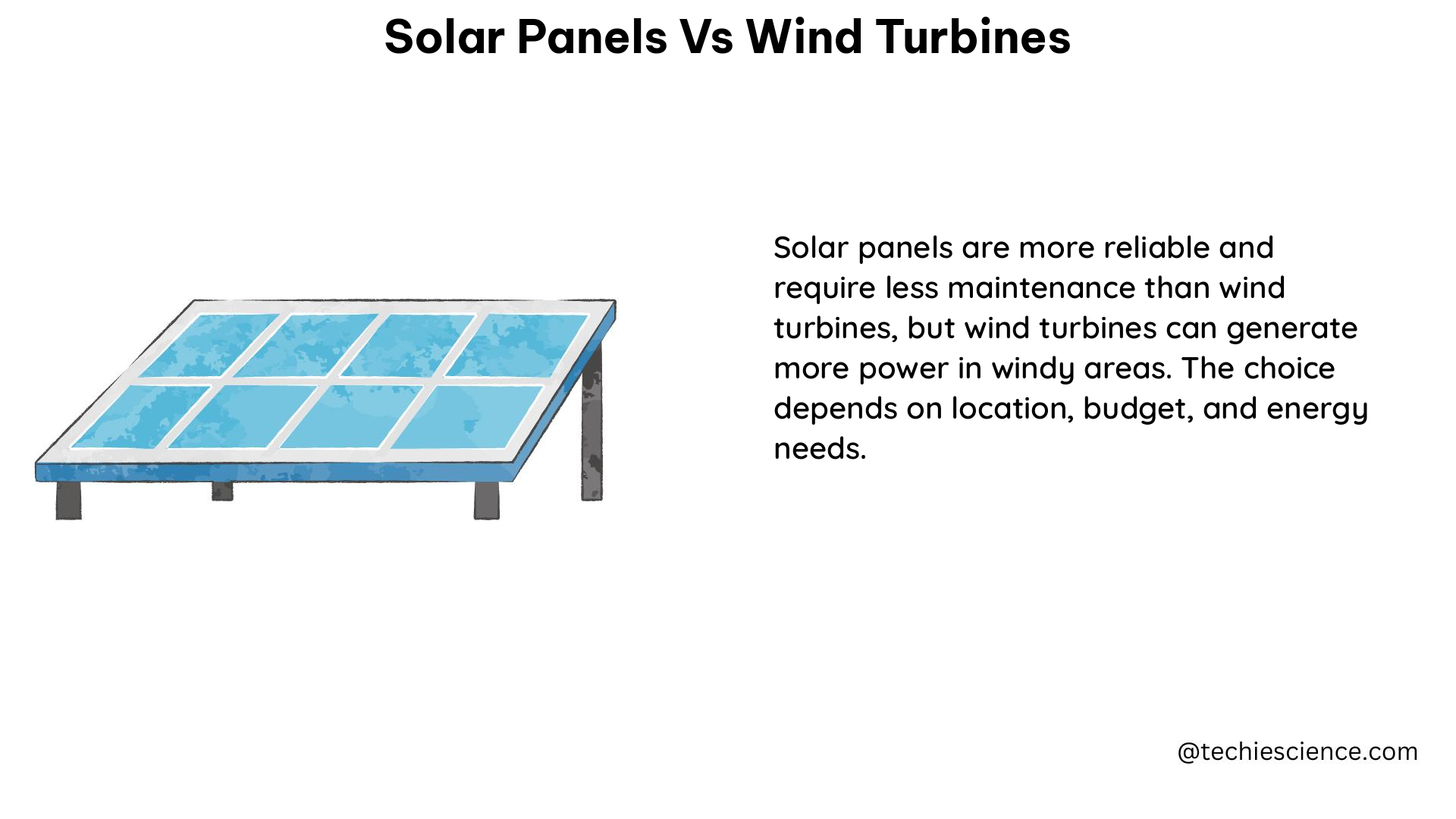Solar panels and wind turbines are two of the most popular renewable energy sources, each with its unique advantages and disadvantages. This comprehensive guide will delve into the intricate details of energy production, technical specifications, and the DIY aspects of these technologies, empowering you to make an informed decision for your renewable energy needs.
Energy Production: Harnessing the Power of Nature
Solar Panels: Capturing the Sun’s Rays
The efficiency of solar panels has been steadily improving, with the most advanced residential models capable of converting up to 22.8% of the sun’s energy into usable electricity. On average, a 10 kW PV solar system can produce around 14,165 kWh per year, enough to power a typical household. Solar panels are highly versatile, as they can be installed on rooftops or the ground, making them suitable for a wide range of residential and commercial applications.
| Solar Panel Type | Efficiency Range |
|---|---|
| Monocrystalline | 16% – 22.8% |
| Polycrystalline | 15% – 17% |
| Thin-Film | 10% – 16% |
Wind Turbines: Harnessing the Power of the Wind
Wind turbines are capable of converting between 60% to 90% of the wind energy they harness into usable electricity. A 10 kW wind turbine can generate an average annual production of around 14,016 kWh, comparable to a 10 kW solar system. However, wind turbines require more space and are typically installed in rural, windy regions due to their size and noise levels.
| Wind Turbine Type | Efficiency Range |
|---|---|
| Horizontal-Axis | 60% – 90% |
| Vertical-Axis | 35% – 45% |
Technical Specifications: Delving into the Details

Solar Panels: Variety and Durability
Solar panels come in various types, each with its own unique characteristics:
- Monocrystalline Solar Panels: These are the most efficient, with conversion rates ranging from 16% to 22.8%. They are also the most durable, with a lifespan of at least 25 years.
- Polycrystalline Solar Panels: These panels have a slightly lower efficiency, ranging from 15% to 17%, but are generally more affordable.
- Thin-Film Solar Panels: These panels have the lowest efficiency, ranging from 10% to 16%, but they are lightweight and flexible, making them suitable for certain applications.
Wind Turbines: Horizontal vs. Vertical Axis
Wind turbines can be categorized into two main designs:
- Horizontal-Axis Wind Turbines (HAWT): These are the most common type, with the rotor and generator positioned at the top of a tall tower. They are highly efficient, with conversion rates ranging from 60% to 90%.
- Vertical-Axis Wind Turbines (VAWT): These turbines have a vertical rotor axis and are less common. They are generally less efficient, with conversion rates ranging from 35% to 45%, but they can be more suitable for urban environments due to their compact size and lower noise levels.
The M-Series by Eocycle, for example, is a HAWT designed for medium to large-scale wind energy projects, capable of generating up to 1 MW of power. These turbines are engineered for durability, high performance, and grid compatibility, making them a popular choice for commercial applications.
DIY Aspects: Hands-On Renewable Energy
While both solar panels and wind turbines can be installed by homeowners, the DIY process varies significantly between the two technologies.
Solar Panels: A Straightforward DIY Approach
Solar panel installation is relatively straightforward for DIY enthusiasts. They have fewer moving parts and require less maintenance compared to wind turbines. The installation process typically involves mounting the panels on the roof or ground, connecting them to an inverter, and integrating the system with the home’s electrical grid.
Wind Turbines: A More Challenging DIY Endeavor
Wind turbine installation, on the other hand, is a more complex and challenging DIY project. These systems are larger, noisier, and require more technical knowledge and resources. Homeowners must consider factors such as tower height, wind speed, and noise regulations, as well as the necessary electrical and mechanical expertise to ensure a safe and efficient installation.
Conclusion
Solar panels and wind turbines both offer viable renewable energy solutions, but the choice between the two will depend on various factors, such as available space, budget, and energy requirements. Solar panels are more versatile, require less maintenance, and are generally more accessible for DIY installation, while wind turbines can generate more electricity per unit and are better suited for large-scale, rural installations.
By understanding the intricacies of energy production, technical specifications, and DIY aspects, you can make an informed decision that aligns with your renewable energy goals and personal preferences. This comprehensive guide has provided you with the necessary knowledge to embark on your own renewable energy journey, whether it’s harnessing the power of the sun or the wind.
References:
– Injured Case – Wind Turbine vs Solar Farm: Which is Better Option?
– Nexamp – Solar Power vs. Wind Energy: Which is Better?
– Ceres GS – Wind Energy v Solar Energy
– Reddit – Testing Solar Panels vs Wind Turbines: Data
– Eocycle Technologies – M-Series Wind Turbines

The lambdageeks.com Core SME Team is a group of experienced subject matter experts from diverse scientific and technical fields including Physics, Chemistry, Technology,Electronics & Electrical Engineering, Automotive, Mechanical Engineering. Our team collaborates to create high-quality, well-researched articles on a wide range of science and technology topics for the lambdageeks.com website.
All Our Senior SME are having more than 7 Years of experience in the respective fields . They are either Working Industry Professionals or assocaited With different Universities. Refer Our Authors Page to get to know About our Core SMEs.